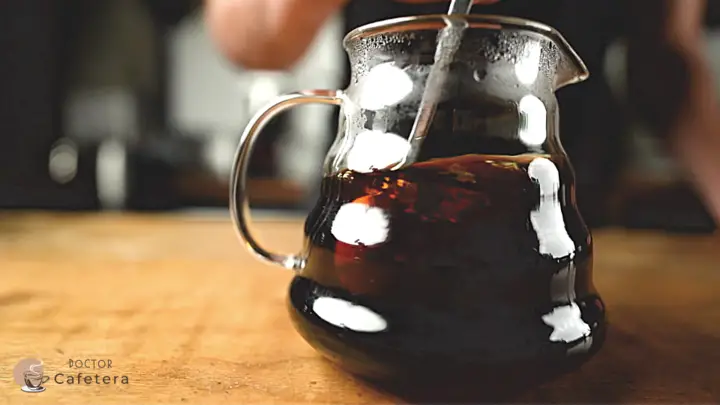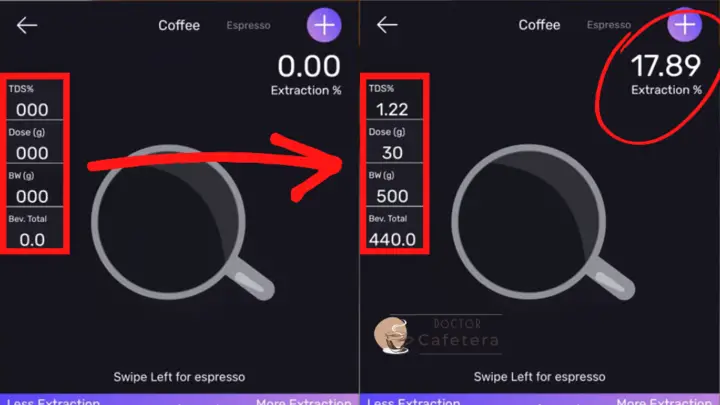Today I will talk about a very interesting instrument, especially for those interested in the more scientific side of coffee. If you want to know a little more about bean extraction and how this affects the taste of the coffee, the refractometer will help you in that sense.
The refractometer is a small electronic device with a built-in prism on which we place a few drops of the coffee we want to analyze. The refractometer illuminates the sample and measures the degree to which this coffee sample refracts the light.
With this measure of refraction of the light, the apparatus indicates the TDS of the sample (Total Dissolved Solids). This data tells us the percentage concentration of soluble substances in the coffee in the water.
➡️For example, if we put a few drops of coffee, it tells us that the TDS is 1.5. This 1.5 percent of our beverage is coffee, and 98.5 percent is water. With this number (TDS), we can obtain the extraction percentage of the coffee bean.
Note: A little more than one-third of the total mass of the coffee bean is water soluble, and with good extraction, we obtain approximately 60 percent of this soluble material.
Keep in mind, though, that not all coffee flavors are desirable, so we don’t want to extract them completely. For this reason, the association of specialty coffee has defined an acceptable range of extraction from 18 to 22 percent of the total mass of coffee.
How is the extraction percentage of a coffee calculated?
Although it may seem an impossible calculation, you will see that it is very simple. For this calculation, we need:
- The % of TDS of a sample.
- The weight of the dry dose.
- The total mass of the final beverage.
To obtain the mass of coffee extracted, we have to multiply the TDS percentage by the mass of the final beverage. This formula lets us know exactly how many grams of our dry dose were dissolved in the water.
Grams extracted = % of TDS x Grams of the final beverage
If we want to know the data in percentage, we divide this number by the mass of dry coffee and multiply it by 100.
Percentage of extraction = (Grams extracted / Grams of the dry beverage) x 100
Mobile application to calculate the extraction percentage of a coffee
For those of you who hate math, don’t run away from this article just yet, because there are smartphone apps that calculate all of this automatically.
Usually, your refractometer brand will have a mobile app for you. However, there are many free ones for both Android and iPhone. The one I am going to show you is called Optimal Coffe Extraction.
Practical use of the coffee refractometer
Before explaining how to use the refractometer, I would like to clarify that apart from achieving between 18% and 22% extraction of a coffee, we have to accompany this measurement of the sense of taste. Each coffee is different, and its flavor will vary greatly depending on our equipment and the technique used to extract it, so the extraction percentage is unique to each circumstance.
Use of the refractometer for filtered coffee
For this example, I use the Hario V60 coffee maker, using my favorite recipe:
- Coffee beans: 30 grams.
- Type of grind: Medium / fine (the ground coffee should be slightly coarser than table salt).
- Filtered water: 500 grams.
- Water temperature: 92 ºC
Note: Keep in mind that the ground coffee will retain twice its weight in water, so I obtain a final beverage of 440 grams.
When the water drains, I see that the total extraction time is 2 minutes and 45 seconds. In principle, it seems a little fast, but using the refractometer is a good situation.
Taking the sample
Once the coffee is at room temperature, I have to stir well with a spoon, as the coffee stratifies, and we need the beverage to be completely uniform.
The refractometer comes with syringes, pipettes, filters, and alcohol wipes. All of these I will use during the measuring process:
- I clean the prism very well with a wipe before placing the sample.
- I find the option to tare to zero in the menu, and with the pipette, I add distilled water to achieve it.
- I take a few drops of coffee from the middle of the coffee jar with the pipette at room temperature.
- I add a few drops of this sample to the prism.
- In the refractometer, I go to the “coffee TDS” menu and press “GO”; this way, I obtain the TDS.
- Now I start the mobile application in the “coffee” part and enter the data of the dry dose (30 grams), the 500 grams of water, and the 1.22 TDS.
- With this data, I obtained an 18.9% extraction rate; that is to say, from those initial 30 grams of coffee, we extracted 5.4 grams of flavor.
When I tasted the coffee, it already felt a little bit sour, so along with the TDS information, I knew I could give it more extraction. For this, I can grind a little finer or pour more slowly.
With the coffee I used in the example if I adjust the grind a little, I know I can get a 19.5% extraction, so I did a second sample with a finer grind and got a TDS of 1.33. This coffee turned out very sweet and complex, with bright acidity and great balance.
Espresso extraction percentage
To calculate the extraction percentage in espresso, we do the same thing, but we will look at other numbers, as espresso is a much more concentrated beverage.
For the espresso test, I use my favorite recipe:
Coffee beans: 18.5 grams.
Type of grind: Fine.
Final drink: 45 grams.
Time: 27 seconds
To take the espresso sample (at room temperature), I stir very well, mixing all the layers of coffee. I use the syringe to extract the sample below the espresso cream, but without touching the bottom of the cup.
Note: The filters that come with the refractometer must be used for espresso and other percolation and immersion methods.
- Tare the refractometer to 0 with distilled water and dry the prism.
- I place the coffee sample with a clean pipette and press the “go” button.
On this occasion, I obtained a TDS of 8.17; from the 18.5 grams of coffee, I obtained 3.7 grams of extracted mass. In the mobile app, this gives me almost 20 percent extraction.
As was the case before, we have to test it to calibrate our recipe until we find the ideal values that give us the coffee we like.
Conclusion
The refractometer is ideal for coffee shops, as well as for roasters. With the refractometer, it is possible to carry out quality control of the coffee obtained each time.
In other words, for all those who work in the industry and those who want to work in the coffee industry, it will help us a lot. However, it is unnecessary if you are only going to prepare coffee at home.



